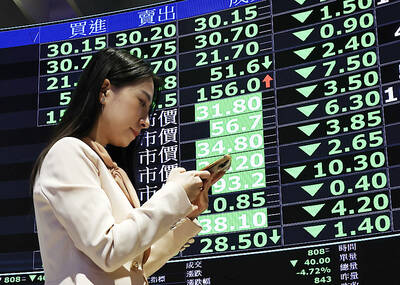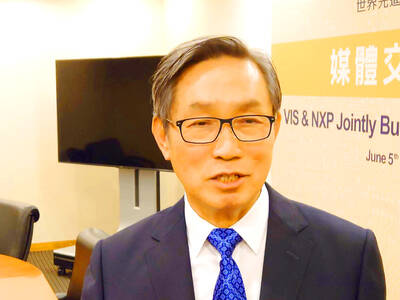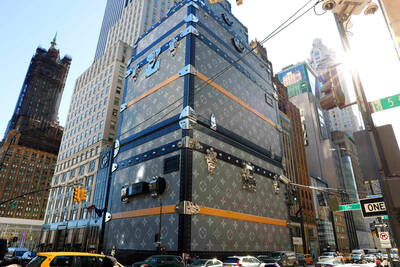Japanese architect Fumihiko Maki has been chosen by a Taiwan consortium to design the Taipei Twin Tower, a new landmark for the capital city scheduled to be launched in 2011, a city official said yesterday.
Maki, 77, has been named by the China Engineering Consultants Inc (CECI,
"The Taipei Railway Station will be rebuilt so that it can link up with the high-speed railway and the Mass Rapid Transit (MRT) line linking the Taipei Railway Station and the Chiang Kai-shek International Airport," Lee said.
"In 2011, foreigners arriving at the CKS airport will take the MRT line to the Taipei Railway Station, and see the Taipei Twin Tower when they come out of the Taipei Railway Station," he said.
The Taipei Twin Tower will be two matchbox-shaped commercial complexes -- one 350m tall with 86 stories, and the other 256m tall with 64 stories.
They will stand west of the new Taipei Railway Station which Maki will also design. Maki has called his design the "Gate of Taipei."
On completion, the Taipei Twin Tower will become Taiwan's third-tallest building after the 508m Taipei 101 and the 378m Tuntex Sky Tower in Kaohsiung.
Taipei 101 is the nickname for the Taipei International Financial Center because it has 101 stories. Currently, it is the world's tallest building.
Maki is the winner of the 1993 Pritzker Architecture Prize and has participated in designing the Free Tower which will replace the New York World Trade Center destroyed in the September 11, 2001 terrorist attack.

TARIFFS: The global ‘panic atmosphere remains strong,’ and foreign investors have continued to sell their holdings since the start of the year, the Ministry of Finance said The government yesterday authorized the activation of its NT$500 billion (US$15.15 billion) National Stabilization Fund (NSF) to prop up the local stock market after two days of sharp falls in reaction to US President Donald Trump’s new import tariffs. The Ministry of Finance said in a statement after the market close that the steering committee of the fund had been given the go-ahead to intervene in the market to bolster Taiwanese shares in a time of crisis. The fund has been authorized to use its assets “to carry out market stabilization tasks as appropriate to maintain the stability of Taiwan’s

STEEP DECLINE: Yesterday’s drop was the third-steepest in its history, the steepest being Monday’s drop in the wake of the tariff announcement on Wednesday last week Taiwanese stocks continued their heavy sell-off yesterday, as concerns over US tariffs and unwinding of leveraged bets weighed on the market. The benchmark TAIEX plunged 1,068.19 points, or 5.79 percent, to 17,391.76, notching the biggest drop among Asian peers as it hit a 15-month low. The decline came even after the government on late Tuesday authorized the NT$500 billion (US$15.2 billion) National Stabilization Fund (國安基金) to step in to buoy the market amid investors’ worries over tariffs imposed by US President Donald Trump. Yesterday’s decline was the third-steepest in its history, trailing only the declines of 2,065.87 points on Monday and

TARIFF CONCERNS: The chipmaker cited global uncertainty from US tariffs and a weakening economic outlook, but said its Singapore expansion remains on track Vanguard International Semiconductor Corp (世界先進), a foundry service provider specializing in producing power management and display driver chips, yesterday withdrew its full-year revenue projection of moderate growth for this year, as escalating US tariff tensions raised uncertainty and concern about a potential economic recession. The Hsinchu-based chipmaker in February said revenues this year would grow mildly from last year based on improving supply chain inventory levels and market demand. At the time, it also anticipated gradual quarter revenue growth. However, the US’ sweeping tariff policy has upended the industry’s supply chains and weakened economic prospects for the world economy, it said. “Now

Six years ago, LVMH’s billionaire CEO Bernard Arnault and US President Donald Trump cut the blue ribbon on a factory in rural Texas that would make designer handbags for Louis Vuitton, one of the world’s best-known luxury brands. However, since the high-profile opening, the factory has faced a host of problems limiting production, 11 former Louis Vuitton employees said. The site has consistently ranked among the worst-performing for Louis Vuitton globally, “significantly” underperforming other facilities, said three former Louis Vuitton workers and a senior industry source, who cited internal rankings shared with staff. The plant’s problems — which have not